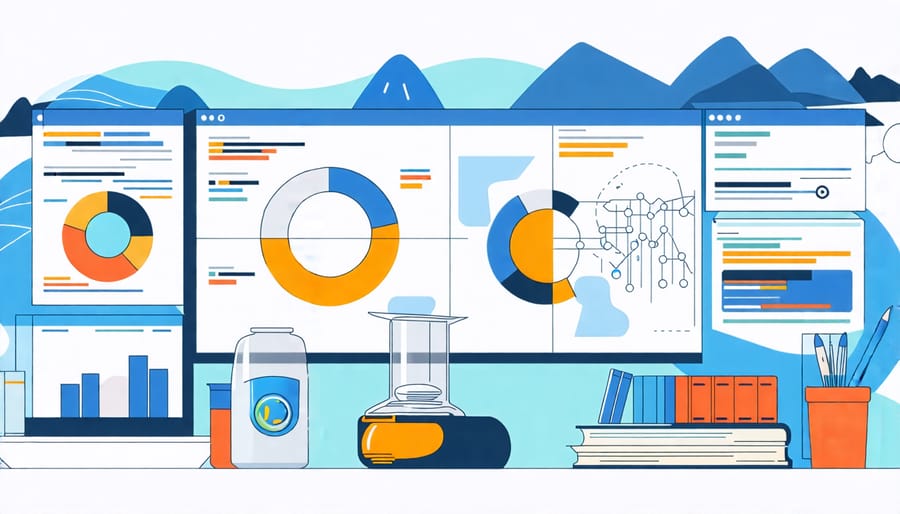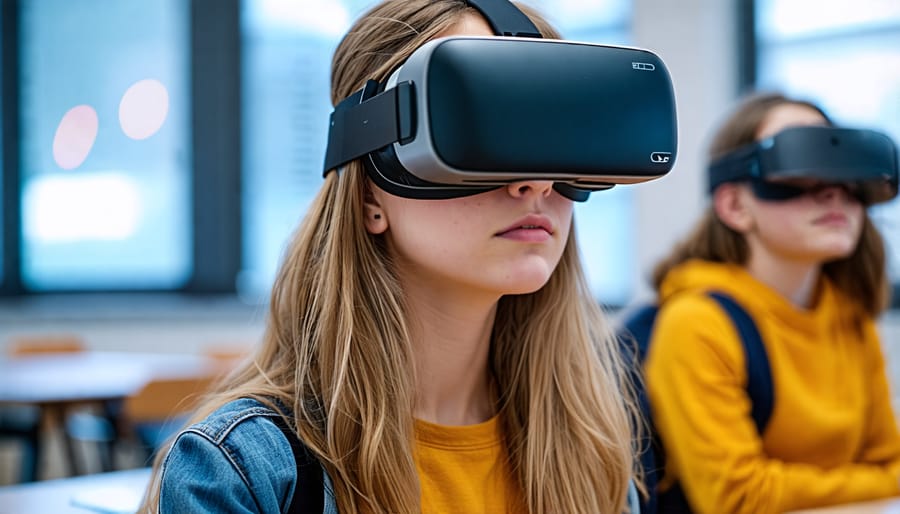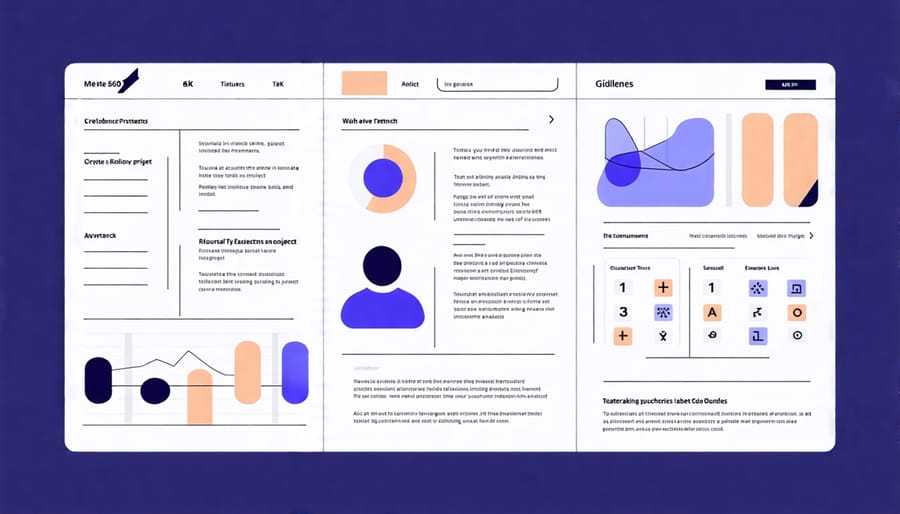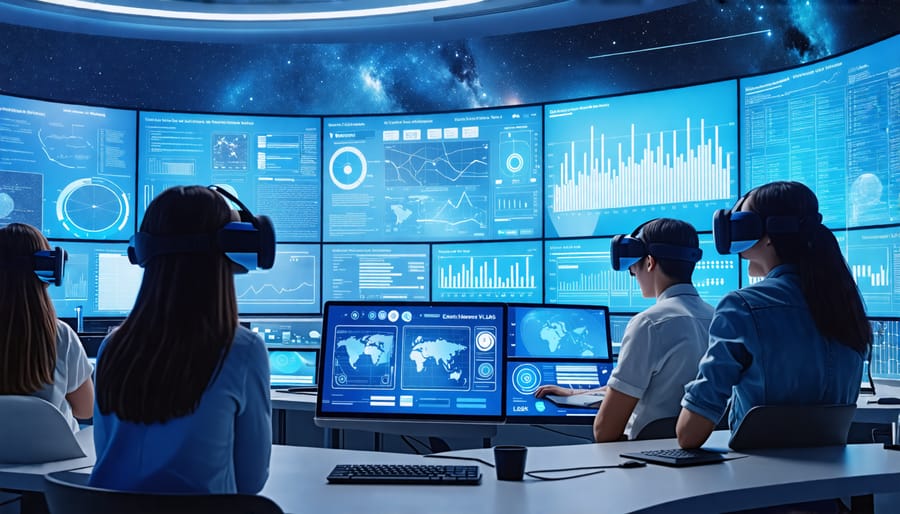Harness digital platforms like online learning management systems to streamline course delivery in Earth Sciences and Physics. Utilize virtual lecture tools, such as Zoom or Microsoft Teams, to facilitate interactive, real-time discussions and foster a collaborative environment among university students.
Implement interactive technologies to enrich the classroom experience. Platforms like Kahoot! and Quizlet can gamify learning, making complex scientific concepts more accessible and engaging for students. Additionally, tools like virtual labs enable hands-on experimentation in a safe, scalable digital format.
Leverage data analysis software to offer students practical experience with tools used in scientific research. Incorporate software like MATLAB or Python into coursework, allowing students to analyze real-world data and enhance their problem-solving skills.
Facilitate communication and resource sharing via dedicated channels. Encourage the use of platforms such as Slack or Google Classroom for ongoing discussions, allowing students to share resources, collaborate on projects, and seek feedback outside of traditional classroom hours. This continuous engagement reinforces learning and supports educational innovation in the field of science.
Digital Platforms and Online Resources
Virtual Labs and Simulations
Virtual labs and simulations have revolutionized Earth Sciences and Physics education by offering safe and accessible hands-on experiences, crucial for understanding complex scientific concepts. In Earth Sciences, these interactive environments allow students to simulate geological processes such as plate tectonics and volcanic eruptions, providing insights without the risk or logistical challenges of fieldwork. Physics students can experiment with dynamic systems, modeling phenomena from quantum mechanics to classical mechanics in a controlled environment, thus reinforcing theoretical knowledge through practical application.
These digital labs democratize education by making high-quality learning resources available to students regardless of their geographic location, effectively leveling the playing field. As Dr. Emily Harper, a researcher in educational technologies, notes, “Virtual labs are closing educational gaps, providing opportunities for immersive learning experiences that were once limited to elite institutions.” By eliminating the constraints of physical labs, students can repeat experiments multiple times, enhancing comprehension and retention.
Moreover, these tools foster a collaborative learning environment where students can experiment together remotely, bridging gaps between classrooms around the world. The inclusion of immediate feedback and adaptive learning paths allows teachers to tailor instruction to individual student needs, optimizing the educational experience. Through these advancements, virtual labs and simulations not only enrich science education but also prepare students to tackle real-world scientific challenges with confidence and creativity.

MOOCs and Open Educational Resources
Massive Open Online Courses (MOOCs) and open educational resources (OERs) are transforming how knowledge is delivered and accessed, especially in disciplines like Earth Sciences and Physics. These platforms and materials provide educators with a wide array of tools to enrich their teaching methods beyond traditional classroom boundaries. MOOCs offer courses from renowned universities, fostering a diverse learning environment where students globally can collaborate and engage. This expansive access democratizes education, allowing learners from different backgrounds to delve into subjects at their own pace.
Meanwhile, OERs—ranging from textbooks to simulation software—are freely accessible, enabling educators to customize content for their curriculum needs. Such resources not only reduce costs for students but also encourage collaborative knowledge building. Dr. Jane Smith, a leading researcher in educational technology, notes, “The adaptability of MOOCs and OERs empowers educators to meet the unique needs of each learner, thus revolutionizing the educational experience.” In practical terms, these tools offer educators in Earth Sciences opportunities to incorporate real-time data and simulations, fostering a hands-on approach to learning complex scientific concepts.
Interactive Technologies
Augmented and Virtual Reality Integration
Augmented and virtual reality (AR and VR) are revolutionizing the educational landscape, particularly within Earth Sciences, by creating immersive learning experiences that were once thought to be the realm of science fiction. Imagine students exploring the depths of the geological formations of the Grand Canyon or walking along the ocean floor, all while seated in their classroom. This is no longer fantasy but a practical application of innovative educational tools.
AR and VR offer unparalleled interactive experiences that help students grasp complex Earth Science concepts, such as plate tectonics or the climatic changes impacting polar ice. By incorporating 3D models and simulations, these technologies allow learners to visualize and interact with phenomena that are geographically distant or conceptually abstract. Dr. Jane Smith, a leading researcher in educational technologies, notes, “AR and VR technologies do not just make learning more engaging; they fundamentally alter the ways students can conceptualize and understand complex geological and environmental systems.”
These advancements parallel quantum breakthroughs in enabling innovative possibilities in kinematic computing used in Earth Science simulations. Universities harness these tools to transform theoretical lessons into experiential knowledge, ultimately fostering a profound appreciation and understanding of our planet’s dynamic systems, thus preparing students for real-world challenges and innovations.

Smartboards and Interactive Displays
Smartboards and interactive displays have revolutionized the way Physics is taught, transforming traditional lectures into engaging experiences that enhance student understanding. By turning static diagrams into dynamic simulations, these tools allow educators to illustrate complex physical concepts vividly. For instance, a teacher can animate electromagnetic waves or model gravitational fields, providing a visual and interactive layer that textbooks simply can’t offer.
Dr. Lila Ortega, a researcher in educational technology, notes, “Smartboards bridge the gap between theoretical physics and real-world application, enabling students to visualize abstract concepts intuitively.” Interactive displays facilitate collaborative problem-solving, where students can manipulate variables and see outcomes in real-time, thus fostering deeper analytical skills.
Moreover, the inclusion of real-world data analysis on smartboards encourages students to connect classroom theory to tangible scientific phenomena, like weather patterns or planetary motions. This ability to link theoretical knowledge with practical scenarios not only prepares students for advanced studies but also inspires a lifelong interest in science.
Data Collection and Analysis Tools
Software for Earth Sciences
In the realm of Earth Sciences, educators are leveraging powerful software tools to bring complex concepts to life through modeling, data collection, and analysis. Notable among these tools are Geographic Information System (GIS) platforms, which enable users to analyze spatial and geographical data effectively. “GIS is not just about maps; it’s a storytelling tool that helps students visualize environmental phenomena,” says Dr. Lucy Tran, a leading researcher.
Seismology software such as SeisNetWatch allows students to track and analyze seismic data in real-time, providing hands-on experience with earthquake research. Advanced weather simulation programs like WRF (Weather Research and Forecasting) Model offer detailed insights into atmospheric processes, enabling students to conduct their own weather predictions.
These tools exemplify the practical application of theory, immersing students in real-world scenarios and encouraging active engagement with the environment. By integrating cutting-edge technology into curricula, educators are equipping the next generation with the skills necessary to tackle planetary challenges, fostering an enthusiastic community of budding Earth scientists.
Physics Analysis Tools
In the realm of physics education, digital tools have become indispensable for both teachers and students, revolutionizing how complex concepts are understood and applied. Among these, software for simulations and calculations stands as a pillar, allowing educators to bring dynamic phenomena to life. For instance, computational software like MATLAB and Mathematica enables intricate modeling of physical systems, providing a hands-on approach to learning that textbooks alone cannot offer. These platforms also facilitate the visualization of abstract concepts, turning complex equations into interactive graphs or animations.
Moreover, tools such as VPython and Geogebra offer user-friendly interfaces for teaching fundamental physics principles through simple yet visually compelling simulations. As Dr. Emily Larson, a professor of physics, notes, “These technologies empower students to experiment in a virtual lab, fostering a deeper understanding of theoretical knowledge.” In the classroom, the impact of quantum technology is also felt, particularly in understanding quantum mechanics, where precise visualization aids comprehension. By integrating these advanced tools, teachers not only enhance learning but also inspire the next generation of scientific innovators to tackle real-world challenges with confidence and creativity.
Collaborative and Communication Tools

Collaborative Platforms in Universities
In universities, collaborative platforms are becoming indispensable tools for joint projects and research. These digital environments allow educators in Earth Sciences and Physics to connect with colleagues globally, share ideas, and drive innovation. Platforms like Slack and Microsoft Teams facilitate real-time communication, while specialized sites such as ResearchGate and Mendeley support knowledge exchange and resource management. Researchers highlight how these tools nurture creativity and interdisciplinary collaboration. “Collaboration has never been more seamless,” notes Dr. Emily Chen, a physics professor. The tangible benefits are evident in student-led projects where these platforms underpin group dynamics and engagement. By combining cutting-edge technology with the resolving power of human intellect, universities can foster an ecosystem of discovery and learning, propelling scientific advancements with an enthusiastic and optimistic outlook.
Enhancing Communication with Technology
In the realm of Earth Sciences and Physics education, technologies are revolutionizing communication between educators and students. Digital platforms such as Zoom and Microsoft Teams enable seamless science review games and interactive sessions, fostering an engaging learning environment. Tools like Google Classroom offer streamlined assignment submissions and feedback, promoting effective collaboration. Dr. Emily Hart, a leading researcher in educational technology, notes that these platforms bridge geographical gaps, democratizing access to quality education. Additionally, platforms like Slack and Discord facilitate real-time discussions, enhancing the traditional learning landscape. In practice, educators at universities employ these tools to create virtual communities, where curiosity thrives, and ideas are exchanged freely. As technology evolves, it holds boundless potential to enrich communication, fostering a dynamic and interconnected educational experience.
Real-World Applications and Success Stories
In recent years, modern educational tools in Earth Sciences and Physics have revolutionized learning experiences at universities and colleges, leading to notable improvements in educational outcomes. For instance, virtual reality simulations allow students to explore complex geological structures or witness the astronomical phenomena without leaving the classroom. This immersive experience has made abstract concepts tangible, enhancing comprehension and retention.
Similarly, interactive digital platforms facilitate real-time data analysis, enabling students to examine the climate change impact by analyzing real-world datasets. These platforms have become invaluable in teaching students how to interpret data, fostering critical thinking and problem-solving skills. An example is the use of Geographic Information Systems (GIS) in Earth Science courses, which has empowered students to model and predict environmental changes with greater precision.
In the field of Physics, adaptive learning technologies personalize educational content, adjusting the difficulty level based on the learner’s progress, thus catering to individual learning paces and styles. Researchers have observed that students using these personalized systems outperform their peers on standardized assessments, showcasing the effectiveness of technology-enhanced education. Such success stories underscore the transformative potential of integrating modern tools into academic curricula, not only making learning more engaging but also equipping students with skills vital for tackling real-world challenges.
Conclusion: The Future of Teaching Tools in Science
The future of teaching tools in science is promising and filled with potential for revolutionary advancements. As technology continues to evolve, educators are increasingly integrating digital platforms and interactive technologies into their teaching methods, transforming how science is taught and experienced. For example, augmented reality can allow students to explore complex physical environments, while virtual labs enable safe experimentation with chemical reactions. Researchers like Dr. Emily Wang, a leading educational technologist, believe that these tools “enhance conceptual understanding and encourage scientific curiosity.” Real-world applications of these technologies are already evident, with universities adopting data analysis software and communication channels that facilitate global interaction and collaboration, encouraging a more comprehensive understanding of scientific subjects. As we look ahead, the ongoing evolution of these tools promises to make science education more accessible, engaging, and effective, equipping students and professionals alike with the skills they need to tackle the challenges of the future with confidence and creativity.

